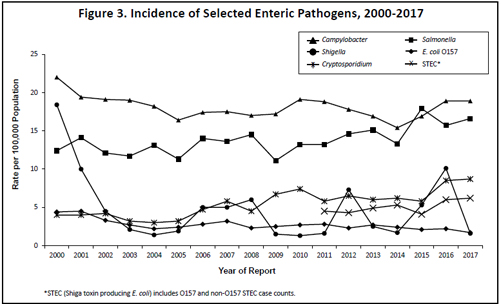Annual Summary of Disease Activity:
Disease Control Newsletter (DCN)
Related Topics
Contact Info
Escherichia coli O157 Infection and Hemolytic Uremic Syndrome (HUS), 2017
During 2017, 96 culture-confirmed cases of Escherichia coli O157 infection (1.74 per 100,000 population) were reported. This represents a 26% decrease from the median number of cases reported annually from 2007 to 2016 (median, 129 cases; range, 115 to 163). Thirty-six (38%) cases occurred in the metropolitan area. Seventy- six (79%) cases occurred during May through October. The median age of the cases was 25 years (range, 11 months to 98 years). Seventeen percent were 4 years of age or younger. Thirty-three (34%) cases were hospitalized; the median hospital stay was 3 days (range, 1 to 16 days). No cases died.
In addition to the 96 culture-confirmed E. coli O157 cases, 246 cases of Shiga toxin-producing E. coli (STEC) infection were identified. Of these, culture- confirmation was not possible in 12, and therefore it is unknown if those were O157 or another serogroup. Among the remaining 234 cases, E. coli O103 accounted for 52 (22%) cases, E. coli O111 for 39 (17%), E. coli O26 for 32 (14%), E. coli O121 for 19 (8%), E. coli O145 for 17 (7%), and E. coli O45 for 2 (1%). The median age of the non-O157 STEC cases was 27 years (range, 5 months to 96 years). Thirty- two (14%) cases were hospitalized; the median hospital stay was 3 days (range, 1 to 18 days). One case, a 3-year-old, died.
CIDTs have become increasingly adopted by clinical laboratories for the detection of Shiga toxin in stool. One hundred ninety patient specimens that were positive by a CIDT conducted at a clinical laboratory were not subsequently culture-confirmed, and therefore did not meet the surveillance case definition for inclusion in case count totals.
Two E. coli O157 outbreaks were identified during 2017. One was associated with person-to-person transmission at a childcare facility in Douglas County. Eight cases, 4 laboratory-confirmed, were identified. One was associated with a restaurant. Eleven cases, 8 laboratory-confirmed, were identified. Falafel was implicated as the vehicle.
Three non-O157 STEC outbreaks were identified during 2017. One outbreak of E. coli O121 infections associated with person-to-person transmission occurred at a childcare facility. Twelve cases, 11 laboratory-confirmed, were identified. An outbreak of E. coli O undetermined infections associated with person-to-person transmission occurred at a childcare facility. Five cases, 2 laboratory-confirmed, were identified. An outbreak of E. coli O111 and O26 infections was associated with animal contact at a campground. Twenty-one cases, 3 laboratory- confirmed, were identified.
Hemolytic Uremic Syndrome (HUS)
In 2017, 9 HUS cases were reported. The number of reported cases is 33% fewer than the median number of cases reported annually from 2007 to 2016 (median, 13.5 cases; range, 10 to 22). In 2017, the median age of HUS cases was 6 years (range, 1 to 35); 6 cases occurred in children less than 7 years of age. All 9 cases were hospitalized, with a median hospital stay of 7 days (range, 3 to 17 days). One case, a 3-year-old, died. From 1997 through 2017, the overall case fatality rate among HUS cases was 5.0%. All 9 cases were post-diarrheal. E. coli O157:H7 was cultured from the stool of 6 cases, E. coli O145 was cultured from the stool of 2 cases, and E. coli O undetermined was isolated from the stool of 1 case. In 2017, there were no outbreak-associated HUS cases.

- For up to date information see:E. coli O157:H7 and HUS
- Full issue>> Annual Summary of Communicable Diseases Reported to the Minnesota Department of Health, 2017